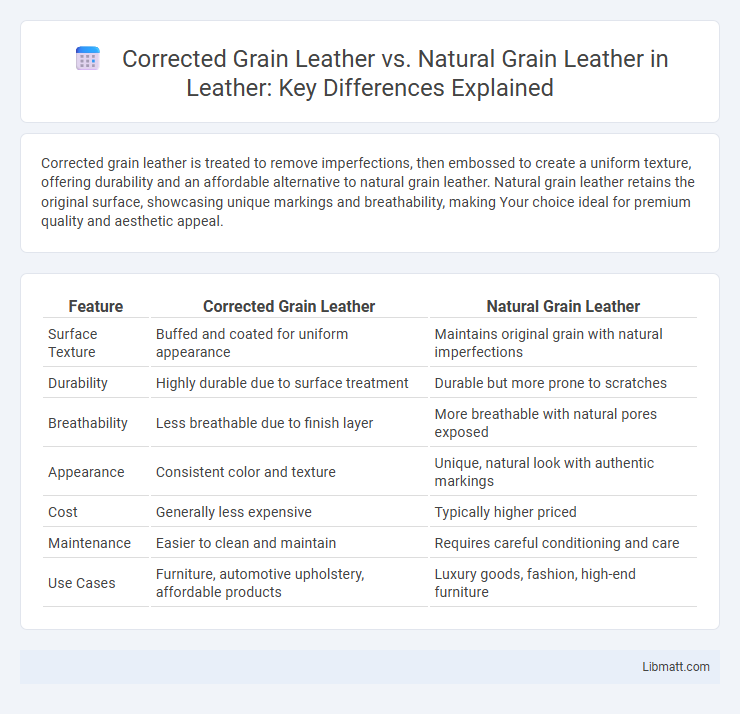Corrected grain leather is treated to remove imperfections, then embossed to create a uniform texture, offering durability and an affordable alternative to natural grain leather. Natural grain leather retains the original surface, showcasing unique markings and breathability, making Your choice ideal for premium quality and aesthetic appeal.
Table of Comparison
| Feature | Corrected Grain Leather | Natural Grain Leather |
|---|---|---|
| Surface Texture | Buffed and coated for uniform appearance | Maintains original grain with natural imperfections |
| Durability | Highly durable due to surface treatment | Durable but more prone to scratches |
| Breathability | Less breathable due to finish layer | More breathable with natural pores exposed |
| Appearance | Consistent color and texture | Unique, natural look with authentic markings |
| Cost | Generally less expensive | Typically higher priced |
| Maintenance | Easier to clean and maintain | Requires careful conditioning and care |
| Use Cases | Furniture, automotive upholstery, affordable products | Luxury goods, fashion, high-end furniture |
Introduction to Corrected Grain and Natural Grain Leather
Corrected grain leather undergoes extensive sanding and buffing to remove imperfections, followed by an artificial grain layer applied for uniform appearance and enhanced durability. Natural grain leather preserves the original surface with all its unique markings, offering a more authentic look and breathability, ideal for premium products. Understanding these distinctions helps you choose the right leather type based on aesthetic preference, durability requirements, and usage context.
Defining Corrected Grain Leather
Corrected grain leather is leather that has been sanded or buffed to remove surface imperfections, then stamped with an artificial grain pattern to achieve a uniform appearance. Unlike natural grain leather, which retains the original texture and markings of the hide, corrected grain leather undergoes extensive processing to mask flaws and enhance durability. This type of leather is commonly used in affordable furniture and accessories where a consistent look is prioritized over natural character.
Understanding Natural Grain Leather
Natural grain leather retains the original surface texture of the animal hide, showcasing unique imperfections and pores that contribute to its authenticity and durability. It undergoes minimal processing, preserving the leather's natural breathability and strength, which enhances aging and patina development over time. This type of leather is often preferred for high-quality products due to its superior resistance to wear and ability to maintain a distinct, organic appearance.
Manufacturing Process Comparison
Corrected grain leather undergoes extensive sanding and buffing to remove imperfections, followed by an artificial grain layer application for a uniform surface, while natural grain leather retains the original grain with minimal processing to preserve its unique texture and natural markings. The manufacturing process of corrected grain leather involves heavy dyeing and finishing steps to mask flaws, contrasting with natural grain leather, which is tanned and finished to highlight the hide's inherent qualities. These distinct processing techniques significantly impact the durability, appearance, and breathability of the final leather product.
Durability and Longevity
Corrected grain leather undergoes extensive sanding and buffing to remove imperfections, which slightly reduces its natural durability compared to natural grain leather, known for retaining its full fiber strength and resilience. Natural grain leather's minimal processing preserves its inherent toughness and ability to develop a rich patina over time, resulting in superior longevity. Both materials offer durability, but natural grain leather typically outperforms corrected grain leather in long-term wear resistance and aging gracefully.
Appearance and Texture Differences
Corrected grain leather features an altered surface with an embossed pattern to mask imperfections, resulting in a more uniform but less natural appearance and a smoother, less breathable texture. Natural grain leather retains its original surface, showcasing unique marks and a rich, textured feel that enhances with age and use. Your choice depends on whether you prefer a consistent look with easy maintenance or the authentic character and breathability of genuine leather.
Cost and Market Value
Corrected grain leather is generally more affordable than natural grain leather due to its processing methods that include sanding and buffing to remove imperfections, making it accessible for budget-conscious consumers. Natural grain leather retains its original surface with minimal treatment, which preserves its durability and unique markings, contributing to a higher market value and demand among premium buyers. Consequently, natural grain leather commands superior resale prices and is favored in luxury goods, while corrected grain leather suits mass-market products with cost efficiency.
Common Uses and Applications
Corrected grain leather is frequently used in furniture, automotive interiors, and footwear where durability and uniform appearance are crucial, offering a more affordable option with enhanced resistance to stains and wear. Natural grain leather is preferred for high-end products like luxury handbags, jackets, and premium upholstery, prized for its unique texture, breathability, and the ability to develop a rich patina over time. Your choice depends on whether you prioritize cost-effective durability or natural aesthetics in the leather's application.
Maintenance and Care Requirements
Corrected grain leather requires more frequent cleaning and conditioning to maintain its appearance, as its sanded and coated surface can wear down over time, exposing imperfections. Natural grain leather demands less intensive maintenance but benefits from regular conditioning to preserve its breathable, durable surface and prevent drying or cracking. Both types of leather should be kept away from excessive moisture and direct sunlight to prolong their lifespan and maintain quality.
Choosing Between Corrected Grain and Natural Grain Leather
Corrected grain leather undergoes surface sanding and coating to conceal imperfections, making it more uniform and durable but less breathable than natural grain leather. Natural grain leather retains the original hide's texture and pores, offering superior breathability, softness, and unique character with every piece. Choosing between corrected grain and natural grain leather depends on the desired balance between appearance uniformity, durability, and the authentic leather experience.
Corrected grain leather vs natural grain leather Infographic

 libmatt.com
libmatt.com